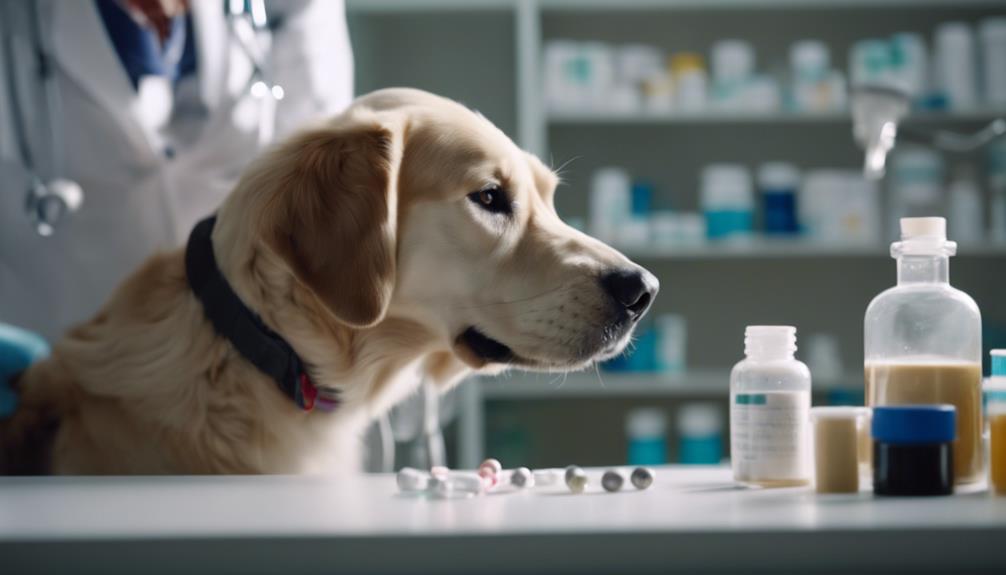Within the intricate realm of canine health, the ability to recognize the subtle indicators of hypothyroidism in dogs stands as a crucial skill for pet owners and veterinarians alike. From lethargy to weight gain and beyond, these signs can often masquerade as common issues, leading to underdiagnosis.
Understanding these manifestations and honing the ability to pinpoint them early can make a significant impact on a dog's quality of life.
As we navigate further into this discussion, uncovering the telltale signs of hypothyroidism will shed light on the importance of proactive health monitoring for our beloved companions.
Key Takeaways
- Hypothyroidism in dogs is common in middle-aged to senior dogs of certain breeds.
- Signs of hypothyroidism include weight gain not related to increased appetite.
- Diagnosis involves physical exams and specific blood tests like Total T4 and Free T4.
- Lifelong treatment with oral thyroid hormone supplements like levothyroxine is necessary for management.
Causes of Hypothyroidism in Dogs
Hypothyroidism in dogs is primarily caused by lymphocytic thyroiditis and idiopathic thyroid gland atrophy, with an additional cause being thyroid cancer.
Lymphocytic thyroiditis occurs when the immune system mistakenly attacks the thyroid glands, leading to decreased hormone production.
On the other hand, idiopathic thyroid gland atrophy's causes remain unknown, resulting in the gradual shrinkage of the thyroid gland and reduced hormone levels.
Thyroid cancer, although less common, can also lead to hypothyroidism in dogs by affecting the normal functioning of the thyroid gland.
Understanding these primary causes is crucial for early detection and effective management of hypothyroidism in dogs.
Dog Breeds Most Susceptible to Hypothyroidism
Among the various factors influencing susceptibility to hypothyroidism in dogs, breed plays a significant role in determining the likelihood of developing this condition. Medium- to large-breed dogs are most commonly affected, with breeds like Labrador retriever, Doberman pinscher, Irish setter, Boxer, and Cocker spaniel being particularly susceptible. Additionally, breeds such as Airedale terrier, Miniature schnauzer, and Dachshund are also at risk of hypothyroidism.
Neutered male dogs and spayed female dogs have an increased susceptibility. Understanding the predisposition of certain breeds can aid in early detection and management of hypothyroidism in dogs, highlighting the importance of breed-specific awareness and monitoring for this condition.
Signs of Hypothyroidism in Dogs

Detecting signs of hypothyroidism in dogs can be crucial for timely intervention and management of this common condition in middle-aged to senior canines.
- Weight Gain: Independent of appetite.
- Lethargy: Unexplained lack of energy.
- Hair Loss: Especially noticeable on the tail and body.
- Cold Intolerance: Seeking warm places or shivering.
- Skin Changes: Dryness, thickening, or darkening of the skin.
These signs, although not specific to hypothyroidism, should prompt further investigation by a veterinarian to determine the underlying cause and provide appropriate treatment.
Diagnosis of Hypothyroidism in Dogs
Efficiently identifying hypothyroidism in dogs necessitates what crucial diagnostic procedures?
The diagnosis of hypothyroidism in dogs is not straightforward due to the nonspecific nature of its symptoms. A physical examination and blood tests are essential for accurate diagnosis. The Total T4 test serves as a screening tool, while the Free T4 test confirms hypothyroidism. It is crucial for veterinarians to consider both the test results and clinical signs in making a diagnosis. Over-diagnosis is common, emphasizing the importance of a thorough evaluation.
Understanding the proper diagnostic procedures is key to effectively identifying and managing hypothyroidism in dogs.
Treatment of Hypothyroidism in Dogs

For the management of hypothyroidism in dogs, oral thyroid hormone supplements, particularly levothyroxine, are commonly prescribed for lifelong treatment.
- Oral Medication: Levothyroxine is the mainstay treatment.
- Lifelong Requirement: Hypothyroidism necessitates lifelong medication.
- Monitoring: Regular T4 level checks are essential.
- Dosage Adjustments: Dosage is adjusted based on T4 levels.
- Preventing Complications: Monitoring prevents hyperthyroidism.
Management of Hypothyroidism in Dogs
In managing hypothyroidism in dogs, the primary approach involves administering oral thyroid hormone supplements, with levothyroxine being a commonly prescribed medication. Levothyroxine is a synthetic form of the thyroid hormone T4 and is crucial for replacing the deficient hormone levels in dogs with hypothyroidism.
Dosage adjustments are typically based on monitoring T4 levels to ensure the dog receives an adequate amount of thyroid hormone. Regular monitoring is essential to prevent the development of hyperthyroidism.
Lifelong treatment is necessary as hypothyroidism in dogs is not curable. Owners should follow the veterinarian's instructions closely to ensure the well-being of their furry companions and manage the condition effectively.
Conclusion
In conclusion, understanding the causes, susceptibility factors, signs, diagnosis, treatment, and management of hypothyroidism in dogs is crucial for early intervention and effective care.
By recognizing the subtle symptoms and utilizing accurate diagnostic procedures, dog owners and veterinarians can safeguard the well-being of their canine companions.
Vigilant monitoring and tailored treatment approaches are essential in managing this endocrine disorder prevalent in certain dog breeds.




